The pandemic is both an acute global public health issue from the point of view of infectious pathology, but also of the impact on the stress level, and implicitly on mental health. The latter effects persist over time through the socioeconomic consequences caused by the pandemic. One of the most important public health indicators at the national level are suicide and suicide attempt, as well as their dynamics during the pandemic. The present study follows, over a period of five years, between 2017 and 2021, the evolution of suicidal behavior in Romania. This period includes the three years before the pandemic (2017-2019) and the first two years of the pandemic (2019-2020), characterized by severe measures to isolate the populations and, as a consequence, the establishment of barriers in the provision of medical care in the field of mental health. In Romania, the suicide rate showed a decrease during the pandemic, with differences according the different geographical area, mentioned in Eurostat as macroregions. There are differences related to the different capacities of the macroregions to provide mental health care during the pandemic. The differences observed on macroregions can also be linked to the differences regarding some socioeconomic indicators. The importance of socioeconomic factors in the dynamics of suicidal behavior is a research topic for the future.
Comportamentul suicidar în perioada prepandemică şi intrapandemică în România (I)
Suicidal behavior in Romania in the pre-pandemic and intra-pandemic period (I)
First published: 30 noiembrie 2022
Editorial Group: MEDICHUB MEDIA
DOI: 10.26416/Psih.71.4.2022.7323
Abstract
Rezumat
Pandemia este deopotrivă o problematică acută de sănătate publică la nivel mondial, din punctul de vedere al patologiei infecţioase, dar şi al impactului asupra nivelului de stres şi, implicit, asupra sănătăţii mintale. Efectele din urmă persistă în timp, prin consecinţele socioeconomice determinate de pandemie. Unii dintre indicatorii de sănătate publică la nivel naţional sunt suicidul şi tentativele de suicid, precum şi dinamica lor în timpul pandemiei. Acest studiu urmăreşte, pe o perioadă de cinci ani, între 2017 şi 2021, evoluţia comportamentului suicidar în România. Această perioadă cuprinde cei trei ani de dinainte de pandemie (2017-2019) şi primii doi ani ai pandemiei (2020-2021), caracterizaţi prin măsuri severe de izolare a populaţiei şi, prin cale de consecinţă, de instituirea unor bariere în acordarea asistenţei medicale în domeniul sănătăţii mintale. O scădere semnificativă a ratei suicidului s-a observat în timpul pandemiei, cu diferenţe în funcţie de diferitele zone geografice ale ţării, menţionate de Eurostat ca macroregiuni. Diferenţele observate între macroregiuni pot fi puse şi în legătură cu diferenţele privind unii indicatori economici. Aceste diferenţe pot fi puse în legătură şi cu capacităţile diferite ale celor patru macroregiuni în a acorda îngrijiri de sănătate mintală în timpul pandemiei. Importanţa factorului socioeconomic în evoluţia comportamentului suicidar este o temă de cercetare pentru viitor.
Introduction
The pandemic represents a major global event, with a significant impact on the population’s existence. Also, a major influence of the pandemic consists in the impact on mental health, both as a major event per se, and as direct postinfectious consequences of COVID-19.
Studies regarding previous pandemics in the history of humanity showed both the increase of suicides during the bubonic plague, and a decrease of suicides during the Spanish influenza pandemic. Moreover, differences in the number of suicides according to socioeconomic status were observed; thus, during the SARS pandemic in China, the number of suicides increased only in the population with a low socioeconomic status(1).
Data show that epidemics may lead to psychiatric pathology or relapse in case of patients already diagnosed with psychiatric disorders(2).
In the recently emerged context of the COVID-19 pandemic in Romania since 2020, it is paramount to address one of the most important indicators of public health status in our country – that is the rate of suicide-related mortality, and morbidity through suicide attempts.
One of the recent theories supports that the main factors that influence suicide ideation and behavior during a pandemic are the level of pandemic-generated fear, potential economic problems, and stigmatization of the infected persons(3).
Aim
We performed a comparative statistical analysis of data from Romania regarding the trend of suicidal behavior during the pandemic compared to the trend prior to the pandemic. We also performed a prevalence and incidence analysis of suicide-related deaths and reported suicide attempts in adults, according to geographical areas (counties). Moreover, we address the influence of socioeconomic factors on the aforementioned trends, according to the four macroregions of Romania (MRs).
Methodology
Sources of information
The statistical data regarding suicidal behavior on a five-year time span, including three pre-pandemic years (2017-2019) and two years of pandemic (2020-2021), were supplied by the Romanian National Institute of Public Health (NIPH).
The data regarding the population of the four macroregions of Romania and additional macroeconomic indicators are in accordance with the information in Eurostat 2020 and the National Institute of Statistics online database – TEMPO Online. There are significant differences in the macroregions of Romania, both regarding the number of inhabitants and economic indicators.
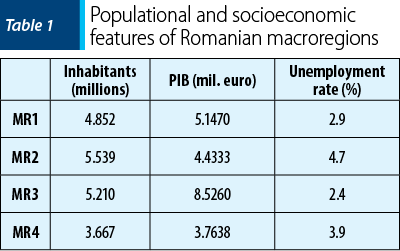

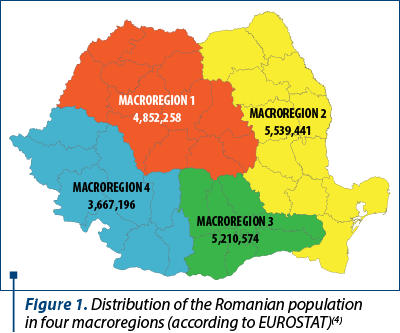
Statistical analysis
The data were grouped and compared from a temporal perspective – individual years, pre-pandemic and during pandemic periods, and a geographic perspective, represented by 42 counties, grouped into four macroregions, according to Eurostat(4). For the statistical analysis, we used t-tests and ANOVA from the SPSS suite. The significance threshold used was 0.05.
Results
Suicide-related deaths
A total of 9155 suicide-related deaths were reported by the NIPH in Romania in the 2017-2021 period, 59.69% of them being reported in the rural area, and 40.30% in the urban area. Also, 15.29% of the aforementioned suicides were reported in females, while 84.70% were reported in male inhabitants.
Both the raw number of suicide-related deaths and the rate of suicides in 100,000 inhabitants exhibited a general trend of decrease in the observed five-year time span. The observed differences are not statistically significant.
The average number of suicides per 42 counties of Romania and per year is 43.60 (standard deviation: ±18.59), with the lowest value in 2020 (41.36 suicides per county) and the highest value in 2018 (48.68 suicides per county).
In each pre-pandemic year observed, we considered counties with a high number of suicides (hns) those that exceeded the year average with +1 SD in the respective year, while the counties with highest number of suicides (HNS) exceeded the year average with +2 SD in the respective year.
In each pandemic year observed, we considered counties with a high number of suicides (hns) those that exceeded the year average with +1 SD in the respective year, while the counties with highest number of suicides (HNS) exceeded the year average with +2 SD in the respective year.
Based on macroregions, the highest number of suicides was reported in Macroregion 2, while the lowest, in Macroregion 4. The observed differences are statistically significant (ANOVA; f-ratio 10.39; p<0.01). We identified statistically significant differences in Macroregions 1 and 2, compared with Macroregions 3 and 4. The direct differences between Macroregion 1 and 2 and between Macroregion 3 and 4 were not statistically significant.
In the pandemic time span observed, deaths by suicide decreased in MR1, MR2 and MR3, while a slight increase was observed in MR4. The differences observed were not statistically significant.
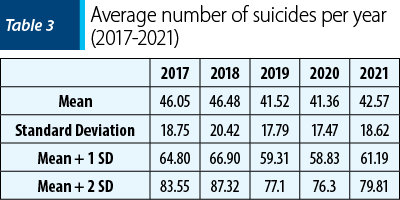
The average suicide rate (per 100,000 inhabitants) is 9.1 per year (SD = ±3,95). The highest suicide rate was reported in 2018 – 9.54/100,000 inhabitants, while the lowest was reported in 2020 – 8.54/100,000. MR1 reported the highest suicide rate, while MR 4 reported the lowest suicide rate. The differences between macroregions are statistically significant (ANOVA; f-ratio 13.43; p<0.01). The highest differences observed are between MR1 and the remaining macroregions.
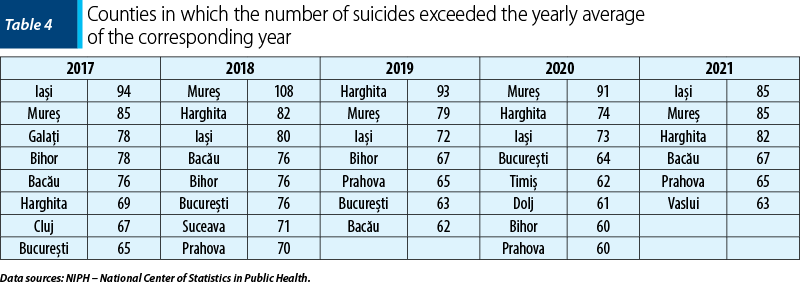
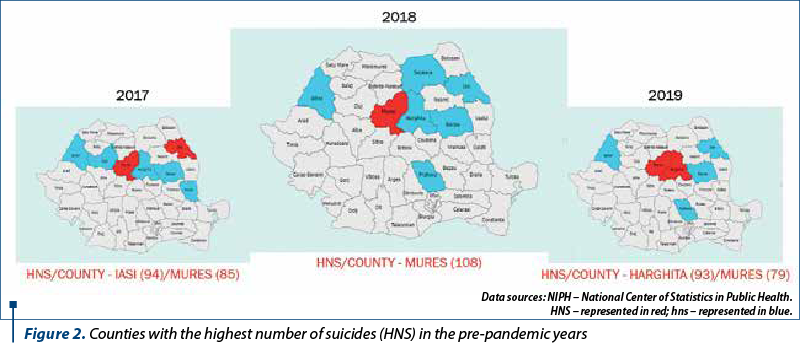
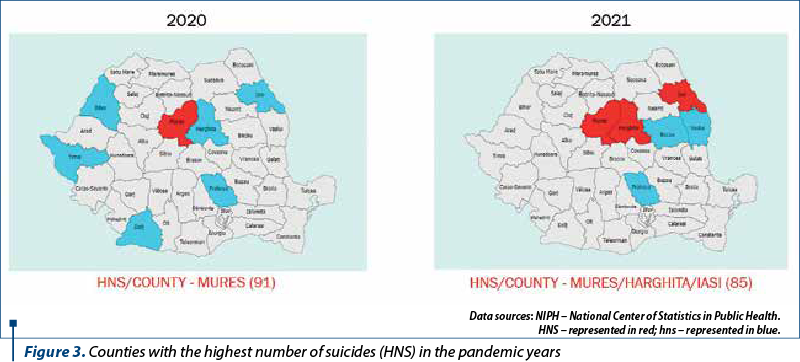






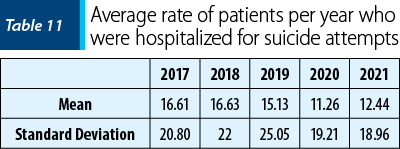
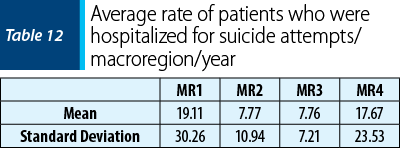

Suicide attempts reported by general practitioners
General practitioners (GPs) reported 3697 suicide attempts according to the ICD-10 code (X60-X84) in the five years analyzed. Also, 44.52% of suicide attempts were reported in the urban area, and 55.47% in the rural area. Moreover, 58.31% of the reported attempts were in male inhabitants, while 41.68% were in female ones. The differences are not statistically significant. There are no significant differences among macroregions regarding the suicide attempts reported by general practitioners (ANOVA; F=1.8; p=0.15). Nevertheless, the highest numbers are in MR4, while the lowest are reported in MR3.
The differences in suicide attempts reported by GPs in the pre-pandemic versus pandemic years are not statistically significant. Decreasing numbers are reported in MR1, with slight increasing numbers are reported in MR1, MR2 and MR3.
Hospitalized patients for suicide attempts
Hospitals reported in the same five years (2017-2021) a number of 2744 discharged patients who were admitted for suicide attempts, based on the following ICD-10 codes: X60-X84, T14.9, Y87.0.
The gender distribution was 57.21% female patients, and 42.78% male patients. There are no available data regarding the area of these patients – urban or rural. The observed differences across years are not statistically significant. Regarding the trend of data reported, a decreasing number of discharged patients who were admitted for suicide attempts was reported in the pandemic years observed, but the differences observed between years are not statistically significant.
An overall decreasing trend is observed regarding the discharged patients who were admitted for suicide attempts in 2017-2021, with the lowest numbers reported by hospitals in 2020, and with a slight increase in 2021.
The differences observed among macroregions regarding the reported suicide attempts by hospitals per year were statistically significant (ANOVA; F=4.76; p<0.01), more specifically between MR1, and MR2 and MR3, respectively. Moreover, we notice a decrease of these numbers in all macroregions in the pandemic versus pre-pandemic years; however, the differences are significant only for MR3 (t-test; p<0.01).
Discussion
The data show an overall decrease of reported suicides from the year 2017 until 2021. Nevertheless, a slight increase was reported in the second versus the first year of the pandemic.
The number of suicide attempts (SA) reported by general practitioners compared to the number of patients admitted for suicide attempts in hospitals are significantly different. One potential explanation of this discrepancy could be the lower danger methods of SAs reported by general practitioners, with no or minimal medical care required in these situations. In Romania, the suicide rate showed a decrease during the pandemic, with differences according to the different geographical area, mentioned in Eurostat as macroregions. There are differences related to the different capacities of the macroregions in providing mental healthcare during the pandemic(5). The differences observed on macroregions can also be linked to the differences regarding some socioeconomic indicators.
Conclusions
Nevertheless, a slight increase of suicide-related deaths was reported in the second year of the pandemic. This increase is potentially alarming for years to come.
The number of suicide attempts reported by general practitioners compared to the number of the patients admitted for suicide attempts in hospitals is significantly different.
The importance of socioeconomic factor in the dynamics of suicidal behavior is a research topic for the future.
Bibliografie
-
Banerjee D, Kosagisharaf JR, Rao TS. The dual pandemic of suicide and COVID-19: A biopsychosocial narrative of risks and prevention. Psychiatry Research. 2021 Jan 1;295:113577.
-
Tucci V, Moukaddam N, Meadows J, Shah S, Galwankar SC, Kapur GB. The forgotten plague: psychiatric manifestations of Ebola, Zika, and emerging infectious diseases. J Glob Infect Dis. 2017;9:151–6.
-
Bitanihirwe BK. Monitoring and managing mental health in the wake of Ebola. Annali dell’Istituto Superiore di Sanita. 2016 Sep 28;52(3):320-2.
-
https://ec.europa.eu/eurostat/data/database
-
Cozman D, Nemeș B, Buciuta A, Dima C, Stoean R. Inpatients psychiatric services use during the COVID-19 pandemic in Romania. Psihiatru.ro. 2021;64(1):26-31.
Articole din ediţiile anterioare
Model de cuantificare a riscului suicidar
Depresia și comportamentul suicidar reprezintă probleme majore de sănătate publică. Deși sunt intens cercetate, puține lucrări din literatură se co...
Eficacitatea psihoterapiei în prevenţia comportamentului suicidar
Suicidul este o problemă globală de sănătate publică, provocând anual aproximativ un milion de decese la nivel mondial. Tendinţele suicidare pot fi...
Eficacitatea psihoterapiei în prevenţia comportamentului suicidar
Suicidul este o problemă globală de sănătate publică, care provoacă anual aproximativ un milion de decese la nivel mondial. Tendinţele suicidare po...
Comportamentul suicidar şi domeniul psihosomaticii
Comportamentul suicidar este un comportament uman cu o cauzalitate complexă, care este legat într-o mare proporţie de afecţiunile psihiatrice. Afec...